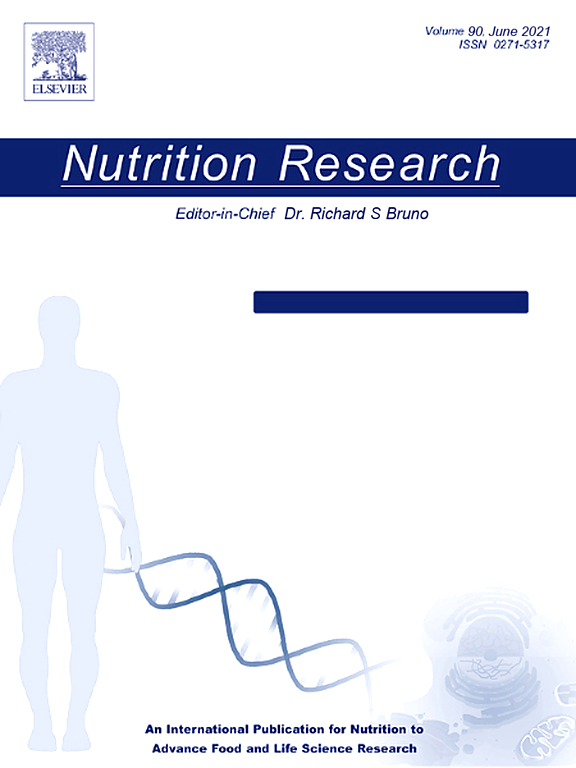Increasing particle size of oat flours decreases postprandial glycemia and increases appetite in healthy adults
IF 3.4
3区 医学
Q2 NUTRITION & DIETETICS
引用次数: 0
Abstract
Consumption of oats is associated with lowered risks of type 2 diabetes and obesity. However, many oat-based products (e.g., breakfast cereals) use finely milled flours but are associated with health claims based on oats of larger particle sizes. The objective of this study was to test the hypothesis that increasing oat flour particle size will result in lower postprandial glycemia and appetite. Using a randomized-controlled, crossover design, 20 participants (10 males, 10 females; age: 25.3 ± 1.0 years; body mass index: 23.2 ± 0.6 kg/m2) consumed a serving of porridge made using 40 g of coarse (675.7 ± 19.6 µm), whole (443.3 ± 36.2 µm), fine (96.0 ± 2.1 µm), or a commercial (375.9 ± 14.8 µm) oat flour unmatched in available carbohydrate, protein, and dietary fiber content. After a 12-hour overnight fast, blood glucose, insulin, and appetite were measured at 15 to 30-minute intervals over 120 minutes posttreatment consumption. Coarse and whole flours led to lower blood glucose between 30 and 60 minutes (P < .02). Blood glucose area under the curve (AUC) was lower after coarse than fine and commercial oat flours (P < 0.03), and after whole than fine oat flour (P < .002). Both coarse and whole oat flours resulted in lower insulin AUC than finer flours (P < .05). Appetite AUC was lower after the commercial than coarse flour (P < .007). Controlling milling to produce coarser oat flour to add to common foods may have health benefits. This study was registered at ClinicalTrials.gov (NCT05291351).
增大燕麦粉的粒度可降低健康成年人的餐后血糖值并增加食欲
食用燕麦可降低罹患 2 型糖尿病和肥胖症的风险。然而,许多燕麦类产品(如早餐谷物食品)使用的是精细研磨的面粉,但却与基于较大粒径燕麦的健康声明有关。本研究的目的是验证增加燕麦粉颗粒大小会降低餐后血糖和食欲的假设。采用随机对照交叉设计,20 名参与者(男性 10 人,女性 10 人;年龄:25.3 ± 1.0 岁;体重指数:23.2 ± 0.6 千克)参加了这项研究:20 名参与者(10 名男性,10 名女性;年龄:25.3 ± 1.0 岁;体重指数:23.2 ± 0.6 kg/m2)食用了一份由 40 克粗燕麦粉(675.7 ± 19.6 µm)、全燕麦粉(443.3 ± 36.2 µm)、细燕麦粉(96.0 ± 2.1 µm)或商用燕麦粉(375.9 ± 14.8 µm)制成的粥。隔夜禁食 12 小时后,在处理后 120 分钟内,每隔 15 至 30 分钟测量一次血糖、胰岛素和食欲。粗面粉和全面粉可使 30 至 60 分钟内的血糖降低(P < .02)。食用粗燕麦粉后的血糖曲线下面积(AUC)低于食用细燕麦粉和商用燕麦粉后的血糖曲线下面积(P < 0.03),食用全燕麦粉后的血糖曲线下面积(AUC)低于食用细燕麦粉后的血糖曲线下面积(P < .002)。粗制燕麦粉和全脂燕麦粉的胰岛素 AUC 均低于细制燕麦粉(P < .05)。食用商品面粉后,食欲 AUC 低于粗面粉(P < .007)。控制研磨,生产出更粗的燕麦粉添加到普通食品中可能对健康有益。本研究已在 ClinicalTrials.gov 注册(NCT05291351)。
本文章由计算机程序翻译,如有差异,请以英文原文为准。
求助全文
约1分钟内获得全文
求助全文
来源期刊

Nutrition Research
医学-营养学
CiteScore
7.60
自引率
2.20%
发文量
107
审稿时长
58 days
期刊介绍:
Nutrition Research publishes original research articles, communications, and reviews on basic and applied nutrition. The mission of Nutrition Research is to serve as the journal for global communication of nutrition and life sciences research on diet and health. The field of nutrition sciences includes, but is not limited to, the study of nutrients during growth, reproduction, aging, health, and disease.
Articles covering basic and applied research on all aspects of nutrition sciences are encouraged, including: nutritional biochemistry and metabolism; metabolomics, nutrient gene interactions; nutrient requirements for health; nutrition and disease; digestion and absorption; nutritional anthropology; epidemiology; the influence of socioeconomic and cultural factors on nutrition of the individual and the community; the impact of nutrient intake on disease response and behavior; the consequences of nutritional deficiency on growth and development, endocrine and nervous systems, and immunity; nutrition and gut microbiota; food intolerance and allergy; nutrient drug interactions; nutrition and aging; nutrition and cancer; obesity; diabetes; and intervention programs.
 求助内容:
求助内容: 应助结果提醒方式:
应助结果提醒方式:


